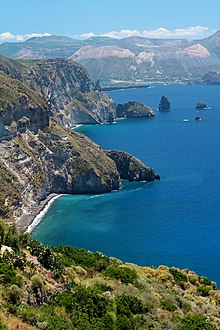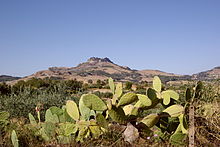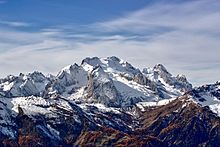Italy
![]()
This article is about the state in Southern Europe. For other meanings, see Italy (disambiguation).
Template:Infobox State/Maintenance/NAME-German
Italy (Italian Italia [iˈtaːlja], officially Italian Republic, Italian Repubblica Italiana [reˈpubblika itaˈljaːna]) is a country in southern Europe; its capital is Rome.
The Italian territory is mostly located on the Apennine Peninsula and the Po Valley, enclosed by the Mediterranean Sea, and in the southern mountainous part of the Alps. The state borders on France, Switzerland, Austria and Slovenia. The small states of Vatican City and San Marino are completely surrounded by Italian territory. In addition to the large islands of Sicily and Sardinia, several island groups are offshore.
As a crossroads of Mediterranean civilizations, the Italian contribution to the cultural and historical heritage of Europe and the world is noteworthy, the territory of today's Italy was in ancient times the core region of the Roman Empire, the Upper Italian Tuscany was the heartland of the Renaissance, followed from Rome by the era of the Baroque.
The Risorgimento gave rise to the modern Italian nation-state: from 1861 to 1946 the Kingdom of Italy existed under the House of Savoy, which rapidly industrialized, rose to become a major European power, and from the 1880s established a colonial empire in North and East Africa. The costly and loss-making participation in World War I from 1915 to 1918 led to the expansion of the national territory, but also to severe social unrest and paved the way to power for the Italian Fascists under Benito Mussolini. The fascist regime ruled Italy from 1922 to 1943-45 and led the country into World War II in 1940 on the side of the Axis powers. Defeat in the war led to the loss of colonies and comparatively minor cessions of territory to neighboring Yugoslavia. In June 1946, a referendum ended the monarchy; the present republic was proclaimed.
Italy is a co-initiator of European integration and a founding member of the European Union, the Council of Europe and the Latin Union. The country is a member of the G7, the G20, NATO, the United Nations (UN), the Organisation for Economic Cooperation and Development (OECD) and the World Trade Organisation (WTO).
According to the Human Development Index, Italy is one of the most developed countries in the world and the eighth largest economy in the world in terms of nominal GDP. The country enjoys a high standard of living and education and has one of the highest life expectancies. Italy is the country with the most UNESCO World Heritage Sites (55) and one of the most visited countries in the world, with around 65 million tourists annually.
Etymology
There are numerous hypotheses for the origin of the word Italia. One of them is that the name is borrowed via Greek from the Oscian Víteliú ("land of calves" from vitulus "calf"). The Greek historian Dionysius of Halicarnassus makes this claim along with the legend that Italy was named after Italos, who is also mentioned by Aristotle and Thucydides.
According to Antiochus of Syracuse, the Greeks initially used the term Italy to refer only to the southern part of the Bruttian peninsula, which corresponds to the region around the present-day municipalities of Reggio and, in part, Catanzaro and Vibo Valentia. By the time of Antiochus, however, the broader designation of Oinotria and "Italy" was used interchangeably, and the name also applied to most of Lucania. According to Strabon's "The Geography," the name was used by the Greeks before the expansion of the Roman Republic to designate the country between the Strait of Messina and the line connecting the Gulf ofSalerno and the Gulf of Taranto. This demarcation corresponds roughly to the present region of Calabria. Gradually the Greeks came to apply the name "Italia" to a larger region. In addition to the hypothesis of "Greek Italy" in the south, historians have proposed the existence of an "Etruscan Italy" covering various areas of central Italy.
In contrast, the boundaries of Roman Italy, Italia, are better defined. Cato's Origines, the first work of history written in Latin, described Italy as the entire peninsula south of the Alps. According to Cato and several Roman authors, the Alps formed the "walls of Italy." In 264 BC, Roman Italy extended from the Arno and Rubicon rivers in the north center of the peninsula to the entire south. The northern area of Gallia cisalpina, Gaul on this side of the Alps, was occupied by Rome in the 220s BC and was considered geographically and de facto part of Italy. However, it initially remained politically and de jure separate until 42 BC, when it was legally incorporated into the administrative unit of Italy by Octavian's Triumvirate as an implementation of Caesar's unpublished acts (Acta Caesaris). The islands of Sardinia, Corsica, Sicily and Malta were added to Italy by Diocletian in 292 AD.
Geography
Italy is located on a peninsula that runs from northwest to southeast and resembles a boot in shape. The maximum north-south extension is slightly less than 1200 km, in the east-west direction is about 700 km. Bordering states are France (length of the common state border: 488 km), Switzerland (734.2 km), Austria (430 km), Slovenia (232 km) as well as the enclaves of San Marino (39 km) and the Vatican City (3 km). The country's borders have a total length of about 2000 km. Italy has an exclave, Campione d'Italia, surrounded by Switzerland. A further border is that to Croatia (sea border). The total length of the coast is 7,600 km.
Morphology
The Apennine mountain range runs through the country along its longitudinal axis and reaches its greatest height of 2,912 m in the Gran Sasso. In the north, a large part of the Alps belongs to Italy: the highest peak is Mont Blanc (Monte Bianco) at 4,810 m, which lies on the border with France. (The course of the border on Mont Blanc is disputed, however. According to the French, Mont Blanc de Courmayeur, at 4,748 m, is the highest peak in Italy). The highest mountain massif that is entirely on Italian soil is the Gran Paradiso at 4,061 m in the Graian Alps.
Along the west coast, stretching from north to south, are the Italian Riviera in Liguria and the Gulf of Naples in Campania, among others. The east coast, from Trieste to the Gargano in northern Puglia (according to other representations: to the Strait of Otranto) is called the Italian Adriatic coast.
The Po Valley (Ital. Pianura Padana) in the north is the largest plain in Italy, covering an area of 50,000 km².
See also: List of mountains and elevations in Italy
Waters
Hydrographically, Italy belongs almost exclusively to the Mediterranean Sea. Only the valley of the Lago di Livigno and the upper part of the Val d'Uina drain into the Black Sea via the Inn and Danube. The Drava, which rises in the Pustertal in South Tyrol, and the Gailitz, which flows through the area around Tarvis, also drain to the Black Sea. Furthermore, the valley of the Lago di Lei drains into the North Sea via the Rhine. The longest rivers are the Po (652 km), the Adige (410 km) and the Tiber (405 km), followed by the Adda and the Oglio. The largest Italian lakes include Lake Garda, Lake Maggiore and Lake Como in northern Italy, and Lake Bolsena and Lake Trasimeno in central Italy.
See also: List of lakes in Italy and List of rivers in Italy
Islands
Italy includes the large Mediterranean islands of Sicily and Sardinia, as well as the archipelagos of the Lipari and Egadi islands to the north and west of Sicily. Around Sardinia are numerous small islands, including Sant'Antioco, Asinara, San Pietro and the archipelago of La Maddalena. The Pontine Islands extend off the coast of Lazio. Also in the Tyrrhenian Sea are the Campania Archipelago (including the islands of Capri and Ischia), the Tuscan Archipelago (including Elba) and the Lipari Islands. In the Adriatic Sea are the Tremiti Islands. The Pelagic Islands, which include Lampedusa, and the island of Pantelleria already belong geologically to Africa.
See also: List of Italian islands
Geology
Due to the geological conditions, earthquakes occur in Italy from time to time. The most violent earthquake of the 20th century, measuring 7.2 on the Richter scale, occurred in Messina and Reggio Calabria in 1908. Around 120,000 people died. In 1915, an earthquake near Avezzano in Abruzzo claimed 30,000 lives. In 1980, the southern Italian region of Irpinia was hit by several strong quakes, the foothills of which stretched from Portici near Naples to Potenza in Basilicata; 3,000 people died. On 31 October 2002, a strong quake hit San Giuliano di Puglia (Molise region): 30 people, including 27 children, were buried in the rubble of a collapsed school building. The 1976 Friuli earthquake claimed 965 lives. On 6 April 2009, a severe earthquake with a magnitude of 5.9 on the Richter scale occurred in L'Aquila, claiming 308 victims, followed by a similarly momentous quake in the Amatrice area in August 2016.
Volcanoes
In addition to the 1281-meter-high Vesuvius, which is in a dormant phase since the last eruption in 1944 and the Phlegraean Fields with their countless thermal springs and fumaroles, on the mainland are several other volcanoes on Italian islands. Most famous are Etna, 3323 metres high, which last erupted in 2018, and Stromboli, 926 metres high and constantly active. Italy is the country with the most active volcanoes on the European continent.
See also: List of volcanoes in Italy
Climate
The climate is subtropical with partly very clear differences in the different regions.
Northern Italy is skirted by the Alps and the Tuscan-Emilian Apennines, limiting the influence of the Mediterranean on the climate. Winters are cool, with occasional light frosts in the towns of the Po Valley, and occasional snow that may remain overnight or for a few days; during the months of November to January, the plain often experiences prolonged periods of dense fog. Summers are long and hot, humidity is high.
Central Italy has milder winters and dry, warm to hot summers due to the influence of the Mediterranean Sea. About south of the 45th degree of latitude, wild pine stands are also widespread. This typical Mediterranean tree species hardly tolerates temperatures below 0 °C and immediately starts to die from below, which is evidence that there are hardly any frosts in these areas.
Southern Italy and the Italian islands have a warm Mediterranean climate almost all year round. Autumn comes late, winters are wet and mild with daytime temperatures of 10 to 15 °C and spring comes early (almond blossom from the end of January). In summer it can be very hot, often reaching temperatures of over 40 °C. Due to low rainfall in the summer months, droughts are a frequent problem in this region.
In the Alps and in the Apennines there is a mostly cold mountain climate due to the altitudes, the summers there are mostly mild.
The mean annual sunshine duration is about 1250 hours in the north, about 1700 hours in the centre (Rome≈1680 hrs) and rises to over 2000 hours in the very south and Sicily.
A new Italian cold record of -48.3 °C was measured at Pala di San Martino in Trentino in December 2010. The highest temperature of 48.5 °C was recorded on 10 August 1999 at the Catenanuova weather station in the province of Enna in Sicily. This is also the highest temperature ever recorded in Europe.
The recent acceleration of climate change has exacerbated existing environmental problems throughout the Mediterranean region, including Italy. For five broad and interconnected areas of impact (water, ecosystems, food, health and security), current changes and future scenarios consistently point to substantial and increasing risks in the coming decades. In large parts of Italy, rainfall is decreasing, while temperatures are increasing and extreme weather events are becoming more frequent. The consequences of these changes are particularly visible in the Alps. Parts of the Planpincieux glacier of the Grandes Jorasses on the border with France, for example, are now threatening to collapse into the valley due to rising temperatures. The consequences are also evident in agriculture. For example, the 2018/19 season in Italy saw the worst olive harvest in 25 years and the Italian farmers' association is already talking about an "olive oil collapse". In Sicily, farmers have started to grow tropical fruits such as mangoes or avocados instead of local oranges or olives because of the changed conditions. The climate crisis also threatens the country's cultural heritage. For example, 13 out of 15 UNESCO World Heritage sites in Italy are threatened by coastal erosion because they are located in the low-lying coastal region.
Nature Conservation
→ Main article: National parks in Italy and regional parks in Italy
In 2014, there were 24 national parks in Italy, covering a total area of around 15,000 km². The Gran Paradiso National Park, known for its Alpine ibex population in the regions of Valle d'Aosta and Piedmont, was the first to be established in 1922. The largest national parks are the Pollino National Park, which extends over 1925 km² in the regions of Calabria and Basilicata and is home to the Italian wolf, the Cilento and Vallo di Diano National Park, with over 1810 km² in Campania, and the Gran Sasso and Monti della Laga National Park, with over 1413 km² in Abruzzo, where the Corno Grande, the highest peak in the Apennines, is located.
In addition, 134 regional parks have been established, covering an area of 13,000 km². The largest regional parks include the Parco dei Nebrodi in Sicily with about 860 km², the Adamello-Brenta Nature Park with about 621 km² in the province of Trento in the Southern Alps, whose establishment also serves to protect the last Italian occurrence of Alpine brown bears, and the Parco dell'Etna with a unique flora and fauna around the volcano Etna with over 580 km².
In 2009, the Ministry of Environment listed 871 aree naturali protette.

Lake Garda near Tremosine sul Garda

Coastline of the Lipari Islands near Sicily
_-_panoramio.jpg)
Gran Sasso and Monti della Laga National Park

Eruption of Etna in 2002, photographed from the ISS

Mediterranean landscape in Sicily

The Marmolata in the Dolomites

The Val Gardena in the Dolomites
Questions and Answers
Q: Where is Italy located?
A: Italy is located in Southern Europe.
Q: What is the official name of Italy?
A: The official name of Italy is Repubblica Italiana.
Q: What is the Italian flag like?
A: The Italian flag is green, white, and red.
Q: What type of government does Italy have?
A: Italy is a democratic republic.
Q: Who is the president of Italy in 2022?
A: The president of Italy in 2022 is Sergio Mattarella.
Q: What is Italy known for when it comes to food?
A: Italy is known for its wine, pasta, pizza, and olives.
Q: What are some famous cities in Italy?
A: Some famous cities in Italy include Rome, Venice, Naples, Turin, Genoa, Florence, Palermo, and Milan.
Search within the encyclopedia